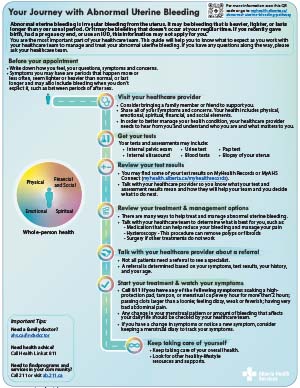Healthcare provider’s assessment
Your healthcare provider will review your history of symptoms and menstrual periods.
They may ask how often, how long, and how much you have been bleeding. Using a
symptom tracker will help you answer these questions.
What to tell your healthcare provider
You are the most important part of your healthcare team. Tell your healthcare provider what impact the bleeding is having on things that are important to you, like your job, hobbies and interests, and relationships.
It’s important to talk about these things with your healthcare provider because they all play a role in your health and well-being.
Making the most of your appointment
If you don’t understand what your healthcare team is telling you, let them know right away. Be open and honest. You might say:
- “This is new to me. Could you please explain it slowly, using language that is easier to understand?”
- “It sounded like you said that I should… Did I understand that correctly?”
- “Can you show me a picture or model to help me understand?”
Learn more about
working with your healthcare team and making the
most of your appointment.

Abnormal Uterine Bleeding Pathway
Download or print the
full patient pathway (PDF) and
summary (one-page PDF) to learn more about how to manage and treat abnormal uterine bleeding.
Patient Pathway  Summary
Summary 
